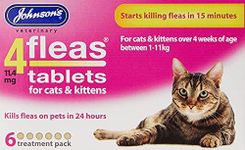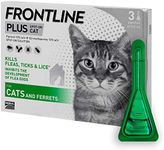Buying Guide for the Best Flea Treatment For Cats
Choosing the right flea treatment for your cat is crucial to ensure their health and comfort. Fleas can cause irritation, allergic reactions, and even transmit diseases. When selecting a flea treatment, consider your cat's age, weight, health condition, and lifestyle. It's important to understand the different types of treatments available and how they work to effectively eliminate fleas and prevent future infestations.Type of TreatmentFlea treatments come in various forms such as topical solutions, oral medications, collars, and sprays. Topical solutions are applied directly to the skin and are effective for immediate relief. Oral medications are ingested and work from the inside out, often providing longer-lasting protection. Collars release active ingredients over time and are convenient for ongoing prevention. Sprays can be used for quick application but may require frequent use. Consider your cat's temperament and your ability to administer the treatment when choosing the type.
Active IngredientsActive ingredients in flea treatments are the chemicals that kill or repel fleas. Common ingredients include fipronil, imidacloprid, and selamectin. Each works differently, targeting fleas at various stages of their lifecycle. It's important to choose a treatment with ingredients that are safe for your cat's age and health condition. If your cat has allergies or sensitivities, consult with a veterinarian to find a suitable option.
Duration of EffectivenessThe duration of effectiveness refers to how long the treatment will protect your cat from fleas. Some treatments offer protection for a month, while others can last up to several months. Consider your cat's lifestyle and exposure to fleas when deciding on the duration. If your cat spends a lot of time outdoors or in areas with high flea populations, a longer-lasting treatment may be beneficial.
Ease of ApplicationEase of application is an important factor, especially if your cat is not cooperative during treatment. Topical solutions and sprays require direct application, which may be challenging with a squirmy cat. Oral medications can be mixed with food, making them easier to administer. Collars are simple to put on but require monitoring to ensure they remain effective. Choose a method that you can comfortably apply without causing stress to your cat.
Safety and Side EffectsSafety and potential side effects should be considered when selecting a flea treatment. Some treatments may cause skin irritation, vomiting, or other adverse reactions. It's crucial to read labels and follow dosage instructions carefully. If your cat has pre-existing health conditions, consult with a veterinarian to ensure the treatment is safe. Monitoring your cat after application can help identify any negative reactions early.



















